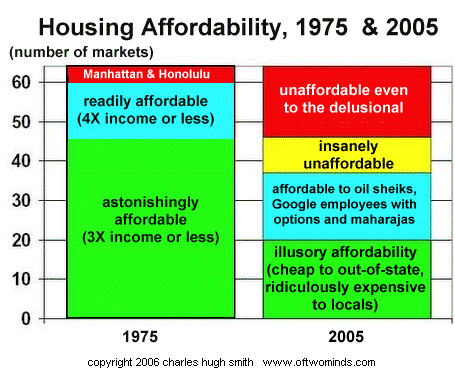

|
| weblog/wEssays archives | home | |
|
Charting Unaffordability (April 8, 2006) 
Through painstaking research of 65 local U.S. real estate markets, I was able to chart the affordability of housing in 1975 and 2005. Rather than bore you with dry statistics, I'll illustrate affordability with actual examples and numbers. Example 1: My father bought a house in a leafy area of Pasadena just a few blocks from Caltech and the Huntington Library for $74,000 in 1974. The equivalent might be the Hollywood Hills or Westwood in L.A., or an excellent neighborhood in Connecticut. Yes, it was a fixer-upper--a large, well-made original house from 1921 which hadn't been "remuddled." It even had a pool and a guest house. I was still in college, but working as an apprentice carpenter; had I been working full-time, I would have earned about $14,000 a year. My girlfriend could have easily made over half that if she'd been working full-time, so without vast skills a young couple could make a bit over $20,000 a year--meaning that a spacious, older fixer-upper (with a guest house, mind you) in a wonderful neighborhood was less than 4 times the income of a young couple just starting out. For my father, a mid-rank executive in a national retailer, it was less than two times income. If two starting salaries could swing the mortgage, then this was still amazingly affordable. Lesser houses in lesser areas were selling for $45,000 or so--only two times a dual income within reach of most workers. Example 2: A few years earlier, in 1971, my mother and stepfather bought a small but charming house perched on the hillside of Manoa Valley, one of the most desirable neighborhoods in what has always been one of the least affordable cities in the country--Honolulu--for $42,000. My stepfather had taken a pay cut from the public school system to work for a private high school, Punahou; he was making about $10,000 a year. My mother worked part-time at Liberty House, a department store. These were typical incomes; that $10,000 salary would be about $48,000 in today's dollars. (To confirm this, go to the Bureau of Labor Statistics website and select the "inflation calculator" from the upper-left heading "Inflation & Consumer Spending.") In other words, a couple with typical incomes could buy a small but pleasant home in a very desirable neighborhood in one of the nation's most expensive cities for about three times their annual income. Example 3: Fast-forward to 1997 and the California city of Albany, a quiet suburb of San Francisco located just north of Berkeley, a town which has long been desirable for its convenient location, walkable shopping district and highly-regarded schools. A couple of friends of ours were working part-time, making about $20,000 each, and they bought a small fixer-upper in Albany for $145,000, less than four times their two part-time salaries (or one unremarkable salary). You did not need a high income to buy a desirable house; you needed only moderate incomes--even two part-time jobs would do the trick. Some other friends bought a perfectly sound, non-fixer house nearby for about $165,000--again, roughly four times a very average wage for one person, or two moderate incomes ($20,000 a year per worker). Now this is for homes in a coveted suburban town in one of the most expensive and desirable areas of the country--the San Francisco Bay Area, a mere 8 years ago. It's important to note here that wages, as has been widely reported, have not even kept up with inflation; as reported in the Wall Street Journal, Wages Fail to Keep Pace With Productivity Increases, Aggravating Income Inequality: Since the end of 2000, gross domestic product per person in the U.S. has expanded 8.4%, adjusted for inflation, but the average weekly wage has edged down 0.3%.In other words, the rise in housing has occured not because of strong wage growth but despite no wage growth. Many people make less than they did in 2000 due to downsizing, and many more have received little or no wage increases in that time, actually falling behind inflation. No doubt you have similar recollections of similar prices and houses in similar locales. So let's look at today. That $20,000 a young couple could make in 1975? About $73,000 in today's dollars. (Interestingly, the BLS reports the average wage in the U.S. is $16.50 per hour, or an annual income of $34,000. Two workers would thus earn about $70,000--confirming that the $73K number is still an average or typical wage for a couple.) The houses in that Pasadena neighborhood? Try $850,000 and up, or 12 times the young couple's income. And the houses in Manoa? Surprise, $850,000 and up. How about a little house in Albany, CA? Our friends cashed out for $550,000 almost two years ago, so figure $600,000, or 15 times their combined salaries. The lack of affordability gets laid on environmental restrictions, but this simply doesn't align with the reality that the same supposedly impossible restrictions were in place 20 years ago--yet houses in the Bay Area were still affordable to typical working stiffs as recently as 8 years ago. Perhaps the real cause is "bubbling" up all around us. For more on the housing bubble and a wide array of other topics, please visit my weblog. copyright © 2006 Charles Hugh Smith. All rights reserved in all media. I would be honored if you linked this wEssay to your site, or printed a copy for your own use. |
||
|
|
home |